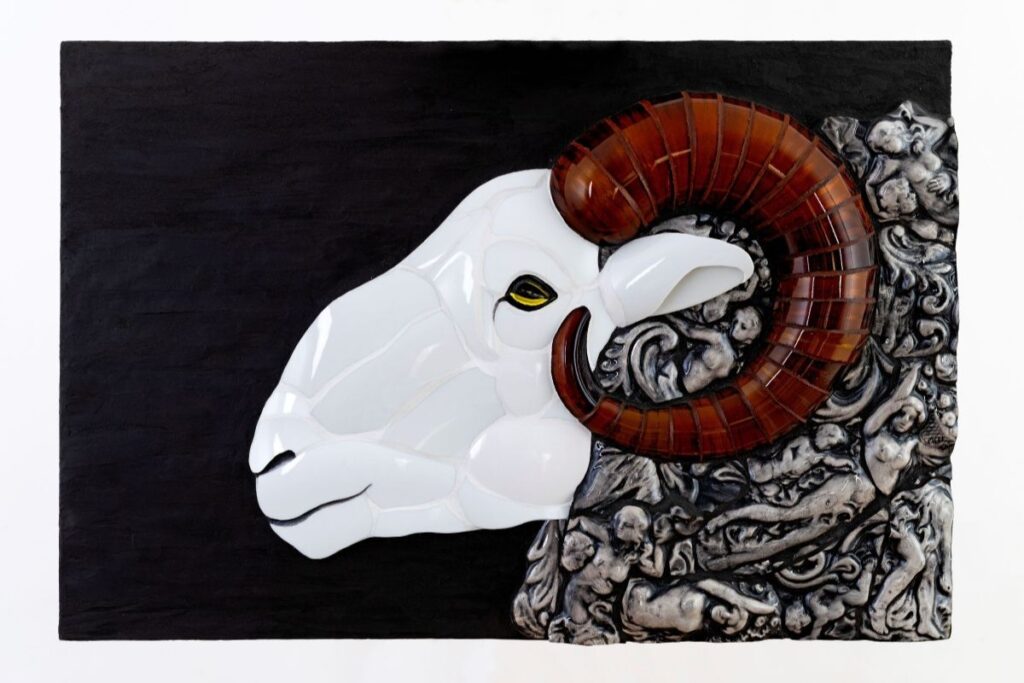In Victoria’s Il-Haġar museum, this season’s exhibition MUZAjk consists of a myriad of small glass shapes and broken pieces of ceramics, glass and stone masterfully reconstructed into nearly 50 colourful works of art by Gozitan mosaicist Mary Portelli.
Portelli’s mosaic career was triggered by finding herself with ‘some broken tiles and the need to make a small stepping stone at home’ and ‘the urge to recycle anything broken and unusable in its original state.’
“Mosaic art boasts a long and winding history that goes far back through the centuries of human existence. In the West, the Mediterranean region and Southern Europe are an especially rich haven for mosaic art,” says curator Marika Azzopardi. “Whilst the very early mosaics were made of pebbles, the technique was eventually transformed with the use of specially cut pieces of stone or marble, called tesserae.”
“Portelli’s captivating and colourful compositions in this exhibition, utilise tesserae in a range of materials from Italian smalti, gold smalti sheet glass, vitreous glass and glass bottles through to ceramic tiles, terracotta, porcelain, elements of jewellery, natural stone such as marble, hardstone or limestone, seashells, flotsam and a variety of found objects,” she explains.
Her Nadur studio, Azzopardi continues, is a place saturated with sacks and boxes of broken crockery, shards of china, remnants of coloured glass and trays of varied hard materials. Some the artist buys, when she is seeking a specific colour or design. Others are brand new but unwanted, left at Mary’s doorstep by well-meaning locals who know of her work.
Portelli is the artist responsible for the sweep of rainbow flowers that greets everyone arriving at Gozo’s Mġarr and, in one of the first rooms in this large show, these colours are replicated in a series of organically-shaped abstract pieces, ‘Sequence’. In this she interprets the seven days in which the world was formed, from The Big Bang to day 7 in which God Rested. Opposite, Black Greed shows skyscrapers on a Maltese coastline, skeletal remains in oil-black waters below, a comment on the rampant greed that is desecrating these islands.
“[Portelli’s] works,” says Azzopardi, “provoke the viewer into asking questions. Look deeper at the mosaic and mentally, emotionally and verbally interact with the meaning of it.”
Mary’s love for the landscape, and a fascination with the rock below our feet, is clear. On the first floor, she focuses on the shapes and strata of the rock beneath our feet, even using zips creatively in one piece, inventively layering them between stripes of crockery for bones. Again, despite the show’s joyous mood, once again there’s an element of pathos, because alongside the blues and browns on local terrain, the poppies on Flanders’ green and yellow fields prove a stark contrast. Here, in glass cases, a mosaic artist’s tools, typical of Portelli’s art and craft, are on display: the hardie and hammer, wheeled nippers, and a glass cutter alongside enticing tesserae.
On the floor above, the sea beyond curves in luscious blues and emerald green onto sandy shores, whilst Portelli’s use of the patterns on broken pieces of crockery in Laying Low masterful. Local views include the citadel, a rich harvest of wheat created with small shells, and look out for the exuberant greenery at the base of Sopu Tower.
Other pieces of particular note are in the lowest room of the museum where, alongside The Sacred Heart, you’ll find Aries, with luscious curved horns and a remarkable fleece made up of classical figures. Here too, two white pieces contrast with the resplendent colours of the rest of the show. These, Beyond the Garden and We Come in Peace. are largely made from the small porcelain and bone china mementoes often given to guests attending a baptism, holy communion or other religious ceremony in Malta. Swans and doves, a camel, a donkey and are other figures tessellated together around the branch of different trees to serve as a collection of memories. Each also includes a tiny mirror to bring your own reflection into the recollections.
In a written tribute (in the accompanying Il-Haġar Gem), Portelli’sproud daughter Stella recalls her mum telling her of this idea. “In my mind, I immediately pictured those ‘tacky souvenirs’ and thought they would completely ruin the mosaic; it was hard for me to imagine anything beautiful coming from what I saw as nothing more than clutter – imbarazz… A few weeks later, I was proven spectacularly wrong. Beyond the (Garden) Wall (of Silence) remains one of my favourites — for both its striking aesthetics and profound symbolism.”
“What [Mary Portelli] has accomplished over the past 17 years is nothing short of remarkable, and I truly believe it deserves to be celebrated. She’s been a true pioneer, bringing a series of firsts not only to Gozo, but to Malta as a whole: the first large-scale public mosaic mural, the first mosaic staircase, and the first mosaic street name plaques.”
MUZAjk runs until November 16 at Il-Haġar Museum, Gozo. Entrance is free.
